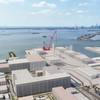DMR Sees US Container Terminal Sector M&A Flurry
M&A (Merger & Acquisition) activity in the US container terminal sector is currently at its highest level since the boom time of the mid-2000s. However, whilst the type of buyer is largely similar to what it was, the rationale for pursuing today’s deals is different, considers Drewry Maritime Research (DMR) in their latest 'Container Insight Weekly'.
The US container terminal sector has seen numerous high profile deals so far this year.Most of the parties on the buy side of the deals are infrastructure and financial players – the same type of buyers that were most active in acquiring US terminals in the mid-2000s. Their aims and motivations today though are somewhat different to what they were.
In the early and mid-2000s, in the run up to the global financial crisis, US container terminals were “selling like hot cakes” to financial investors. There was strong competition to acquire them and prices paid hit record levels in many vases (in excess of 20 times EBITDA).
This exceptional blip was caused by a combination of high expectations about future volume growth prospects and a large pool of available low-cost money looking for somewhere to invest. Businesses such as Maher Terminals were acquired by RREEF (Deutsche Bank) and OOCL’s terminals in New York/New Jersey and Vancouver were bought by Ontario Teachers’ Pension Plan. Goldman Sachs took a 49% stake in SSA Marine’s parent company and AIG acquired P&O Ports North America (POPNA) from DP World (as a forced sale), with POPNA ultimately becoming part of the Highstar Capital owned Ports America brand.
US terminal throughputs had been booming since the early 2000s due to the combination of the entry of China into the WTO and good US economic growth. However, the global financial crash sent US container volumes into reverse and they have only just recovered to their pre-crash level (see Figure 1 here).
Currently, another buying spree is underway, but why are financial investors still interested in US container terminal businesses? After all, it is a mature market with relatively low, single digit growth prospects. The terminals operate in a country with amongst the most unionised and highest cost dock labour in the world, and EBITDA percentage margins are relatively low by world standards.
There are several reasons to today’s enthusiasm
- Firstly, acquisition prices for container terminal businesses are much lower today than they were in the boom period (typically 8-12 times EBITDA today).
- Secondly, whilst EBITDA margins of terminals are relatively low in percentage terms, the US has some of the highest terminal tariffs in the world, so the absolute EBITDA per box is significant.
- Thirdly, the US represents a low risk, stable place to invest, which suits many financial players’ investment criteria.
- Fourthly, automation is gathering pace in US terminals, offering the chance to reduce labour costs by making capital investment instead. The terminal developed by APMT in Virginia makes extensive use of automation and has been in operation since as early as 2007. It is now being joined by Global Container Terminal in New York/New Jersey which has recently implemented a significant degree of yard automation. Meanwhile on the west coast, two major terminal re-developments are taking place which include installation of extensive automation – OOCL’s Long Beach Container Terminal and the MOL (TraPac) terminal in Los Angeles. The precise extent to which automation results in lower labour costs for US terminals re
There are two key factors likely to generate more M&A activity in the US terminal sector over the coming months. Firstly, the continuing financial pressure on carriers may motivate more of them to sell stakes in their terminals. Secondly, financial investor churn is evident. Investors that put money into terminals in the mid-2000s are reaching the stage where an exit is sought as funds reach maturity.
The focus of this additional deal activity is likely to be more on the USWC that the USEC, as private terminal ownership is more prevalent on the west coast. In addition, carrier ownership of terminals is most prevalent on the USWC.
Drewry's View
The US container terminal sector is once again a hot spot for M&A deals, albeit the driving factors are somewhat different to what they were. More deals may well be seen in the coming months.
Source: Drewry Maritime Research –'Container Insight Weekly'.











